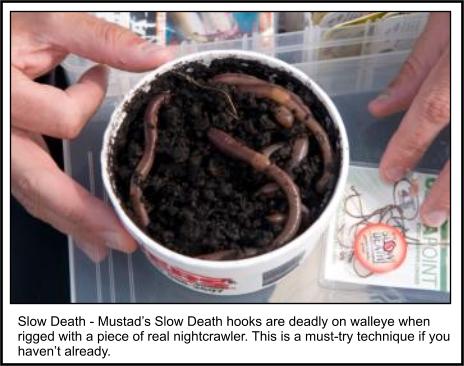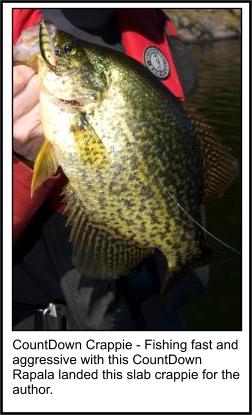|
 Live
or Artificial Bait? Live
or Artificial Bait?
By Tim Allard*
Whether to use live or artificial bait can be an angling dilemma.
Both types have a time and place to be used. Your fishing style and
the kind of angling youíre doing will influence whether live or
artificial is best. Letís review the strengths and weaknesses of
each in detail.
Benefits of the Real McCoy
Put plainly: live bait works. Itís at its best when fish
are fussy and when getting bites requires a subtle presentation. A
misconception is that live bait is for beginners. While itís true
that many of us learned to fish using it, advanced anglers - like
guides and walleye tournament pros - still rely on live bait in
certain scenarios. For example, ďslow deathĒ is a walleye trolling
technique that combines a specialty hook with a piece of worm to
produce a corkscrewing action thatís irresistible to fish.
Real bait also has an appeal with youngsters. As a child I used a
lot of live bait. Partly because I had confidence in it, but also
because I caught my own. I have vivid memories of creeping in my
backyard with a flashlight looking for worms at night, and setting
my minnow trap at a local creek. Bait collecting was an adventure on
its own, hooking fish later was another element all together. If
youíve got youngsters, catching baitís a great way to add variety
and fun to the overall fishing experience.

Live Bait Shortcomings
A downside of live bait is you need to care for it and keep
it fresh to maximize its appeal. There are products available for
storing and transporting nightcrawlers, leeches, and minnows, but
the reality is pet-sittingís mandatory.
Supply can also be an issue. Trying to get two dozen quality minnows
on a long weekend in cottage country can be a challenge. Plus, live
bait can be messy when not handled properly; spill the dirt from a
container of store-bought worms on a boatís carpet and youíre in for
a cleaning hassle.
 Generally speaking, live bait can foster a slower fishing style.
This is good when fish are fussy or if youíre keen on relaxing, but
often a medium to fast approach increases your odds of catching more
fish by covering more water. Using live bait when trolling is a
noteworthy exception. Generally speaking, live bait can foster a slower fishing style.
This is good when fish are fussy or if youíre keen on relaxing, but
often a medium to fast approach increases your odds of catching more
fish by covering more water. Using live bait when trolling is a
noteworthy exception.
Lastly, bait buckets (i.e., minnow carriers) can hide unwelcome
hitchhikers. Thereís an ever-growing list of invasive species
infiltrating our waterways and these containers can cause trouble
when misused. If using a bait bucket you should empty it on land
(well away from the shoreline) before leaving any waterbody. Also,
buy live bait locally, never dump it into the water, and donít
release aquatic organisms from one water system into another.
 Artificial
Benefits Artificial
Benefits
Artificial baits are designed to fill in the weakness of
live offerings. Where evolution has given creatures mechanisms to
avoid being eaten, tackle companies do the opposite and engineer
baits to attract predators and entice them to bite.
Thereís a plethora of artificial baits for a variety of fishing
conditions. There are: lures to fish fast, slow, or at a medium
pace; baits you can bring through weeds without getting stuck;
models that float, sink, or suspend; ones that make a ruckus with
rattles and spinning blades; and, baits infused with fish-attracting
scent. Having an assortment of artificial baits provides options on
how to fish different scenarios and ways to target fish in varying
moods (i.e., active to inactive).
Artificials also donít require upkeep. With a selection of
hard-baits in a tackle tray and soft-baits in sealable bags youíre
set up for the season. You can leave these items in your boat or at
the cottage and be ready to fish any time. Thereís no
bait-babysitting. There are also soft-baits that are biodegradable,
like Berkley, Ecogear, and Food Source Lures products.
Artificial Hurdles
The abundance of bait choice can be overwhelming for
beginners, but with a bit of research and a chat with a tackle shop
employee you can quickly get outfitted with quality artificials to
catch your favourite fish.
As artificials are inanimate objects, you must work them to make
them come alive. This takes practice and time. This might discourage
some, but the rewardís the fun of learning different tactics and
catching fish doing it.
Cost is sometimes perceived as a disadvantage. Yet when you break
down their lifespan compared to a dozen worms or minnows,
artificials prove a more cost-effective investment. Of course,
loosing a $10 hard-bait is never easy.
Lastly, some believe that artificials simply arenít as good as the
real stuff. In some cases this is true, but itís not a fair blanket
statement. In many instances a properly presented artificial will
outperform live bait. Experimenting with both live and artificial
baits will test this assumption; itíll also reveal the strengths and
weaknesses of each option, making you a well-rounded angler in the
long run.
When trying to decide between buying and using live or artificial
bait, consider their strengths and weaknesses, your style of
fishing, and what you want from an angling experience. With these
factors in mind youíll find the choice becomes an easy one.
*Tim Allard of Ottawa, Ontario is a
hard-water expert and author-photographer of the newly released
book, Ice Fishing: The Ultimate Guide. For more information visit:
www.helipress.com/product/ice-fishing-138.cfm
Editors & Publishers
T.J. & Monique Quesnel
|
The
Ontario Fishing Network
E-Magazine is
published 12 times a year on or near the beginning of every month. Our
magazine is geared to any angler who enjoys fishing of any type in the
wonderfully diverse province of Ontario. Editorial Submissions: We welcome query letters,
but assume no responsibility for unsolicited materials. Subscriptions: Subscriptions are FREE of charge
and delivered via email.
You can subscribe
HERE: Privacy Policy: Unlike other publications We
NEVER make our subscribers list (your email address) available to any
other companies. Advertising: If you are interested in advertising
please email us. Circulation - 12,000 email subscribers
© 2010 Due North
Marketing / Ontario Fishing Network / T.J. Quesnel. All rights
reserved. Reproduction of any material without prior written
permission strictly prohibited. |
|